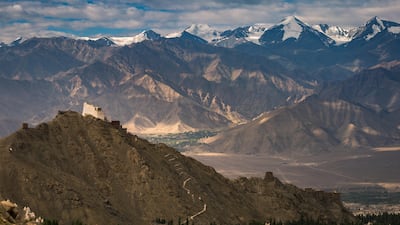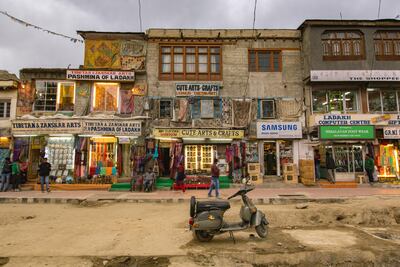Why Leh?
Leh is the largest town in Ladakh, the mountainous, arid desert region of Jammu and Kashmir, India, located in the Indus river valley. Ladakh is home to ancient monasteries, glacial rivers, deep turquoise lakes and vast vistas of some of the highest and most spectacular rugged mountains in the world, such as the Himalayas and the Karakoram. Originally a stop for trading caravans on the Silk Route, today Leh is the gateway to vast stretches of snow-covered mountains and valleys, including one of the world’s highest passes – the Khardung La, at 5,359 metres. The region is an intrepid trekker’s paradise, with great flora and fauna from wild Himalayan roses to marmots. Ladakh also has colourful festivals which are cultural extravaganzas with dance, drama, and music. It’s like a little piece of Tibet that most people cannot see, and easier to access than Tibet is.
A comfortable bed
If you’re planning well-ahead, the most glamorous option is TUTC’s tented Chamba Camp, near Thiksey monastery, which opens again in May. With luxurious tents, fitted out with four-poster beds and bathrooms with copper sinks, this is a plush affair. There are two restaurant tents at the camp offering multi-cuisine, besides a living room tent with a small library and boutique. The camp organises activities from monastery visits to bird watching and picnics. Tented accommodation in a luxury suite, for three days with guided tours, activities and food, starts at around Rs103,000 (Dh5,800) per person – see the website tutc.com chamba-camp-thiksey.
Another option is Shakti Ladakh, which tailors offbeat trips, where you stay across six traditional rural homes and meet villagers and visit local schools, monasteries and markets. An eight-day all inclusive package with food, accommodation, trips, porters and guides is around US$6,198 (Dh22,766) per person.
If you want to stay in Leh Town, then Hotel Grand Dragon is a good choice. This hotel decorated with intricately carved wood, reminiscent of Ladakhi palaces, offers large and spacious rooms with magnificent views of the Leh Palace and the mountains. The restaurant serves Ladakhi, Chinese and Tibetan cuisine. Doubles start at around Rs 10,200 (Dh580) per night with breakfast.
Find your feet
Walk through the main street of Leh town, with its mud brick houses and narrow alleys, packed with souvenir shops and the Tibetan Refugee Market. Looming above is the mud, wood and stone Leh Palace, which used to house the royal family and was later abandoned. It is nine storeys high and has been recently renovated. While climbing up to it, don’t miss the restored 17th century home called Munshi Mansion, which gives you an insight into how Ladakhi homes looked long ago. It now houses the Ladakh Arts and Media Organisation. Visit the Central Asian Museum on the Main Bazaar Road, Leh, that showcases artifacts like utensils, manuscripts, hand-written Qurans, coins and rock art, from Central Asia, Kashmir and Tibet, as old as 400 years. Entry costs Rs50 (Dh3).
Catch the sunset from the Shanti stupa with its white dome against a barren landscape, set on a high hill and built by the Japanese – you will have to climb 500 steps to get a view from the top. Go for an early morning prayer at the 15th century monastery, Thiksey, with a stunning 49-feet high statue of Maitreya Buddha. The monastery spread across a 12-storey complex has a Tara Temple, the kitchens, the monk’s quarters, and the Prayer Hall. The terrace is great for a panoramic view of the valley and the mountains.
Meet the locals
Wander in the back streets behind the Jama Masjid in the town's main bazaar. This is lined with bakeries with mud tandoor ovens churning out freshly baked rotis. This is where the locals shop for bread and also fresh cottage cheese (paneer). Stroll in the main market and buy apricots and fresh produce, interacting with elderly locals. Visit the school for young monks at the Hemis monastery. They chant mantras and even play football with vigour.
Book a table
Head to Bon Appetit, a local favourite, which serves sandwiches, burgers and thin crust pizzas besides creamy pastas. Don’t miss their chocolate momos. Chang Spa Road, opposite Moravian Mission School. A meal for two here cost Rs600 (Dh35).
Lala’s Art Café, located in an old, restored Ladakhi home, in Old Town, has low seating on a terrace. You can taste local specialties like Tsampa (roasted barley) or Khambir (Ladakhi bread) (Rs 60/Dh3) and pastas (Rs150/Dh8). Have local butter tea at Rs60 (Dh3).
For a upmarket meal head to Cloud café at TUTC’s Chamba Camp, Leh-Manali Highway, Thiksey, a garden restaurant that serves and European specialties. They offer a good lunch buffet at Rs605 (Dh35).
Shoppers’ paradise
The Tibetan Refugee market is a great place to shop for trinkets and souvenirs from prayer wheels, silver artifacts, music bowls, and thangka paintings to beaded jewellery and statues of the Buddha and Tara. Buy apricot juice and jam from shops in the main bazar. Shops in the main market road also sell pashmina shawls of different qualities in a wide price range. For stylish clothes which fuse western sensibilities with Ladakhi craftsmanship and materials like yak and camel wool, head to Jigmat Couture in Leh town. The boutique at TUTC’s Chamba Camp also stocks designer jewellery, pashmina shawls and local artefacts.
Don’t miss
The flight into Leh is over some of the most spectacular landscapes – do get a window seat. Don’t miss a trip to the Nubra valley with sand dunes, and the sparkling blue, high altitude, Pangong Lake. You can stay at TUTC’s Diskit camp, near the Diskit monastery. There is the colourful Hemis Festival in June/July at the Hemis Monastery, outside Leh. An unusual and quirky sight is the donkey sanctuary in Leh that gives shelter to injured and weak donkeys.
What to avoid
Leh is located at an altitude of 3,524m. That means less oxygen, so remember to acclimatise. Make sure you don’t take part in strenuous activities for the first two days. Drink plenty of fluids and get used to the thin air. Symptoms of acute mountain sickness (AMS) include headache, breathlessness and nausea. If you suffer a headache or any other symptoms, consult a doctor who may prescribe Diamox. Most hotels and tented camps are equipped with oxygen cylinders. You can also burn from the sun at this high altitude, so plenty of sunscreen and sunglasses are a must.
Getting there
Jet Airways, an Etihad Airways partner airline, offers return flights from Abu Dhabi to Leh via Delhi from Dh1,608 return including taxes. Alternatively, fly to Delhi with Emirates, Etihad, FlyDubai and Air India in four hours from Dh1,270 return including taxes and book the 90-minute connecting flight to Leh separately.
_________________
Read more:
My Kind of Place: Chittogarh, India
My Kind of Place: Lucknow, India
My Kind of Place: Varanasi, India
_________________


